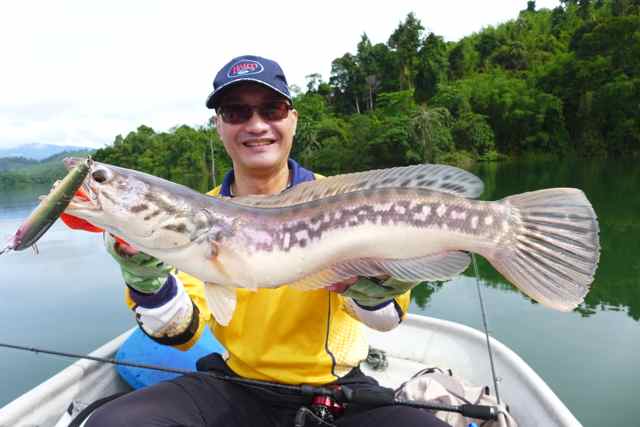
Do single hooks catch toman?
by Christopher S.G. Tan
This question was brought up during a Q & A session at the 2015 Angling & Outdoor Recreational Fair. Dave Hodge (a.k.a. The Barefoot Fisherman), known for his fishing skills, was giving a talk and demonstration. He was asked about the use of single hooks on crankbaits. The question then turned to the use of these hooks on toman. “Hodgie” then suddenly turned to the audience where I was sitting and asked me what I thought.
That caught me off guard. I had to try and recall what I normally did. Most of the larger lures I use for toman come equipped with treble hooks that are strong enough for me. It was normally only the small lures that had the hooks changed to single hooks. Therefore for reasons of financial economy I normally would not change the hooks out for singles.
I had in the past caught toman on single hook equipped crankbaits but had never formed an opinion on whether the single hooks were an advantage or disadvantage for toman fishing in terms of hook-up rate. After a moment of consideration I gave the answer that I found both as effective for me with no particular preference for either one.
This question piqued my interest in finding out whether single hooks on crankbaits would be as effective as trebles. For freshwater fish like sebarau I have not found single hooks to be lacking but instead very effective.
In fact, the lack of extra hook points made the chances of landing sebarau higher when they dove into snags as they were unable to stick any exposed hook points into structure to dislodge or lever open the hooks. This enabled the sebarau to be successfully brought out of the snag while still connected to the lure. I figured that this would probably prove to be a plus point for toman too as they are renowned for diving into submerged timber or brush and unhooking themselves.
For my trip to Air Ganda, I made sure I changed the hooks on the lures I was planning to use for toman. My normal favourite toman lure is the Tilsan barra and I changed all the hooks on these lures to size 1/0 or 2/0 Mustad Kaiju In-line single hooks. I also decided to try them on the Halco Laser Pro 120 MT. This lure is 12cm in length and has a body shape similar to that of the lomar, which is a common forage for the toman in Air Ganda dam. It also has a moderate roll and action which I found that the toman in Air Ganda favour. I have not had much success there with crankbaits that have a hard thumping action.
Throughout the trip we spent most of our time doing quick-draw casts to rising toman. Most of them were small toman. The hook-up rate on my single hook equipped lures was good and I did not have any regrets for using single hooks as all the strikes were converted to positive hook-ups this trip. There are some trips where the toman judiciously nip at the lures or just carefully nudge them, and no matter how sharp the treble or single hooks are, getting a positive hook-up can be nigh impossible!
I had one memorable bite when I cast a LP120 Fluoro Green to a rise. After a few cranks the lure was grabbed viciously and the toman dove down pulling the heavy drag steadily! Then in those few brief seconds I felt the line being rubbed against a branch. The pulling stopped. A second later the line went slack and I wound in the leader minus the lure. The toman must have wrapped the leader around the branch and broken off the lure.
A few minutes later we saw the toman rise in the distance, waving the bright green lure to irritate us. It still had the green lure pinned onto it by the single hooks. We hung around casting to rises and we saw it rise a second time to wave the the green lure again, seemingly mocking me. No doubt it would shed the single-hook-equipped lure in a day or two once it tired of its new piece of tackle-wear. I press down the barbs of the single hooks to allow better hook point penetration and easier removal.
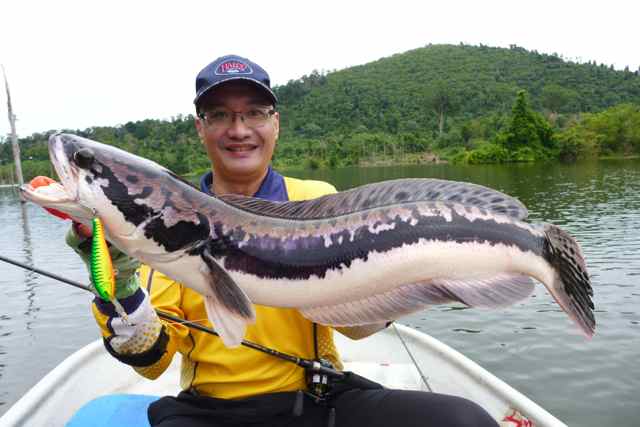 Later in the afternoon, we were chasing a school of toman fry whose parents stubbornly refused to take the lures we were casting. Many, many casts later the fry were moving along a bankside which was littered with branches and vines in the water. Still persisting, I cast a "mango green" Tilsan barra and was rewarded with a hook-up, and after a brief tug-of-war the toman buried itself in the snags.
Later in the afternoon, we were chasing a school of toman fry whose parents stubbornly refused to take the lures we were casting. Many, many casts later the fry were moving along a bankside which was littered with branches and vines in the water. Still persisting, I cast a "mango green" Tilsan barra and was rewarded with a hook-up, and after a brief tug-of-war the toman buried itself in the snags.
With some careful easing of pressure on the line and a bit of waiting the toman was eased out and fought again before it was successfully landed and released back to its babies. In past experience, if the lure had treble hooks on, then when the toman buried itself in a snaggy area, it would most likely free itself, as the many other exposed hook points of the treble would enable the toman to lever itself free.
Looking back at the trip on which I used solely single hooks on the crankbaits, I decided that I found the use of appropriate single hooks to be fine for toman. There was no doubt about that.
Choosing the right single hook – a balanced outfit
The Mustad Kaiju In-Line single hooks have the right balance of strength and thickness for the tackle I normally use for toman. These are medium power rods of 8-17lb range or maybe the 10-20lb range. Its hook thickness balances nicely with the striking power of these rod powers.
 If the hook is too thick, you will need a stiffer rod to impart enough force to set the hook. At times, the hook point will need to pierce through the upper jaw of the toman which is made of plates of hard bone. To get the hook to penetrate fully, a lot of hook setting force needs to be used.
If the hook is too thick, you will need a stiffer rod to impart enough force to set the hook. At times, the hook point will need to pierce through the upper jaw of the toman which is made of plates of hard bone. To get the hook to penetrate fully, a lot of hook setting force needs to be used.
I remember one occasion when we went to Fish Valley, Semenyih to test some lures on the toman there. Single hooks are required there and the ones provided to replace the trebles on the lures were very heavy duty thick ones. I was using a light outfit and found that after every hook-up, the toman would throw the lures frequently. Once I figured out it was because the hook wire thickness prevented the hook from fully penetrating through the hard mouth structure of the toman, I made more effort to set the hook.
However the light rod was too soft and springy to be effective so I went back to my car to change to the heavier set up which was a medium power rod. Even then, it was difficult to get a positive hook-set although I made sure I would set the hook firmly! I ended up doing repeated strikes immediately after the bite to try and push the thick hook deep in. This gave me a better retention rate but there were still toman that still got away. Ideally the thick hook wire for these single hooks would need a heavy power rod with less give to set the hooks properly.
This experience was a good illustration of the need for balanced tackle in all aspects. Even the hook wire thickness needs to be balanced with the rod power to achieve a good hook-set for fish with tough jaws like toman.
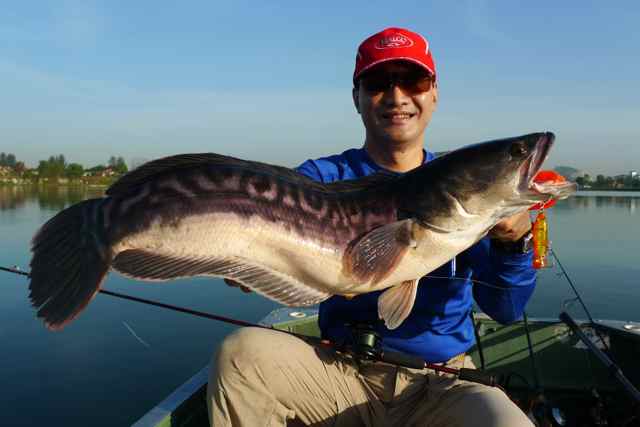
A light power rod, a small Halco Roosta Popper with small medium gauge single hooks was able to penetrate this toman's mouth
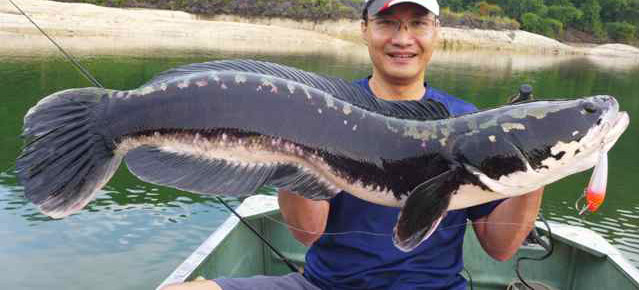
A fast action 10-17lb rod (medium power) was used to set the Mustad single hook on the Halco Hamma into this big toman.
Conservation
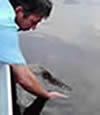
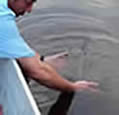
We need to protect and conserve our resources by practising catch and release of our sportfish and protecting the habitat of our fishes.
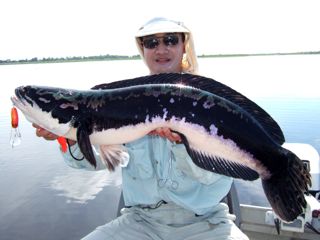
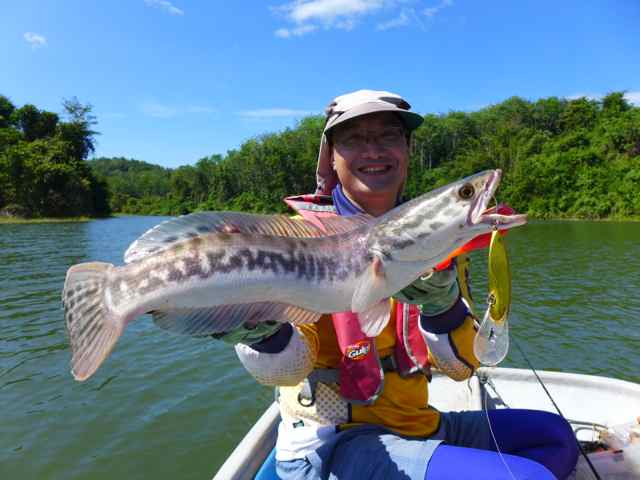
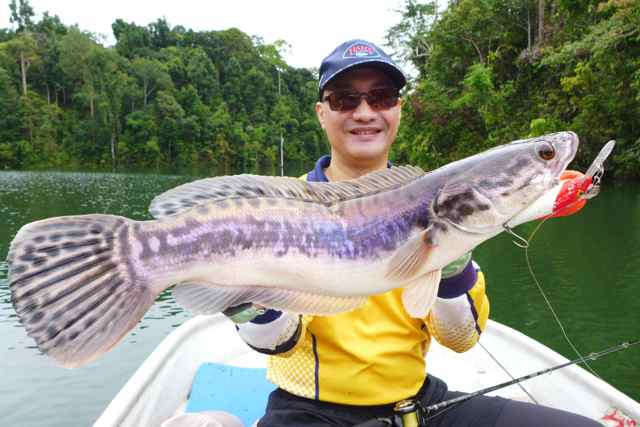


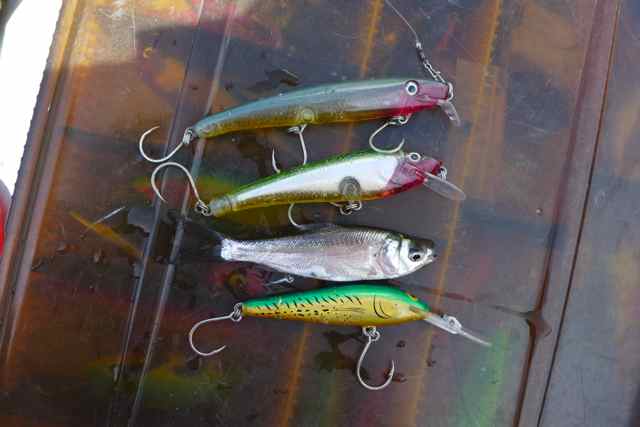 The lures equipped with Mustad In-line singles that are of similar size to the toman's forage in Air Ganda dam – Halco LP120 MT, Halco Hamma 105, a real lomar and the Tilsan Barra. The lomar can be seen in schools roving the inlets and coves of the dam.
The lures equipped with Mustad In-line singles that are of similar size to the toman's forage in Air Ganda dam – Halco LP120 MT, Halco Hamma 105, a real lomar and the Tilsan Barra. The lomar can be seen in schools roving the inlets and coves of the dam.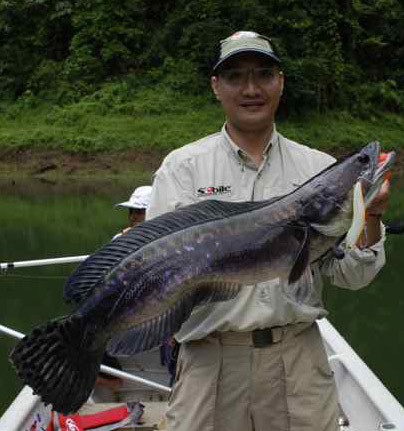
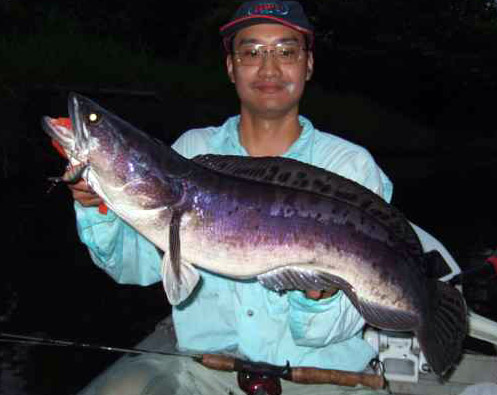 The small Tilsan Bass lure is equipped with single hooks that are much stronger than the original trebles.
The small Tilsan Bass lure is equipped with single hooks that are much stronger than the original trebles.